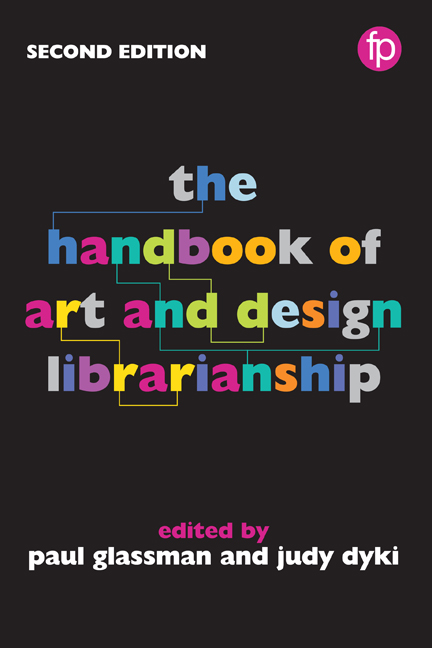Book contents
- Frontmatter
- Contents
- List of figures and tables
- Notes on contributors
- Foreword
- Preface
- Part I Roles and responsibilities
- Part II Materials and collection management
- Part III Teaching and learning
- 14 Embedded in their world: moving mentally into the studio environment
- 15 Teaching with threshold concepts and the ACRL Framework in the art and design context
- 16 Teaching by the book: art history pedagogy and special collections
- 17 Metaliteracy in art and design education: implications for library instruction
- 18 The art of evidence: a method for instructing students in art history research
- 19 ‘I want students to research the idea of red’: using instructional design for teaching information literacy in the fine arts
- 20 Cultural differences and information literacy competencies
- Part IV Knowledge creation
- Part V The physical environment
- Part VI Promotion and sustainability
- Appendix Library profiles
- Index
16 - Teaching by the book: art history pedagogy and special collections
from Part III - Teaching and learning
Published online by Cambridge University Press: 08 June 2018
- Frontmatter
- Contents
- List of figures and tables
- Notes on contributors
- Foreword
- Preface
- Part I Roles and responsibilities
- Part II Materials and collection management
- Part III Teaching and learning
- 14 Embedded in their world: moving mentally into the studio environment
- 15 Teaching with threshold concepts and the ACRL Framework in the art and design context
- 16 Teaching by the book: art history pedagogy and special collections
- 17 Metaliteracy in art and design education: implications for library instruction
- 18 The art of evidence: a method for instructing students in art history research
- 19 ‘I want students to research the idea of red’: using instructional design for teaching information literacy in the fine arts
- 20 Cultural differences and information literacy competencies
- Part IV Knowledge creation
- Part V The physical environment
- Part VI Promotion and sustainability
- Appendix Library profiles
- Index
Summary
Introduction
We are now nearly two decades into the new century, and the digital revolution continues to accelerate. Big data, social media and virtual reality – these are just the latest phenomena to push the boundaries of library collections and services. Busy students with expectations of immediate, remote access to content can find the print-dependent art library anachronistic and frustrating. The concept of slow scholarship and the pedagogical strategies of ‘deceleration, patience and immersive attention’ are a hard sell when faculty must contend with large lecture courses and paper deadlines loom. As academic art libraries strive to be relevant in an increasingly digital world, it is worth reflecting on the character and usefulness of their least accessible yet most distinctive holdings – special collections. For meditations on slow learning and temporal intelligence in art history pedagogy, see Singerman (2016, 73–84) and Roberts (2013) respectively.
Scope and value of special collections
The term ‘special collections’ is inexact and is interpreted differently by individual libraries. Here it refers broadly to those materials afforded extra physical protection, usually through closed shelving, mediated handling and climate control. Although antiquarian books are a core component – so much so that ‘special collections’ and ‘rare books’ are often used interchangeably – it should be emphasized that many modern and non-codex materials are candidates. Criteria for special collections include rarity (survival in limited numbers), fragility (the need for special handling), vulnerability to mutilation and substantial market value. For an extended discussion of the policies and selection criteria used to identify special collections and rare books materials in art research libraries, see Rinaldo (2007).
An individual selection need meet only one of these criteria, and even libraries that supposedly do not collect rare books will find items in stacks or vertical files that merit added protection. Examples commonly found in art libraries, beyond antiquarian books, are avant-garde journals, broadsides, contemporary artists’ books, exhibition ephemera and fine facsimiles. Audiovisual materials are not addressed in this chapter although they are part of special collections in many art libraries and bring with them related security and preservation challenges. At colleges and universities where special collections are concentrated in a central rare books department, they are nonetheless a resource that will benefit from the art librarian's attention.
- Type
- Chapter
- Information
- The Handbook of Art and Design Librarianship , pp. 157 - 168Publisher: FacetPrint publication year: 2017
- 1
- Cited by



